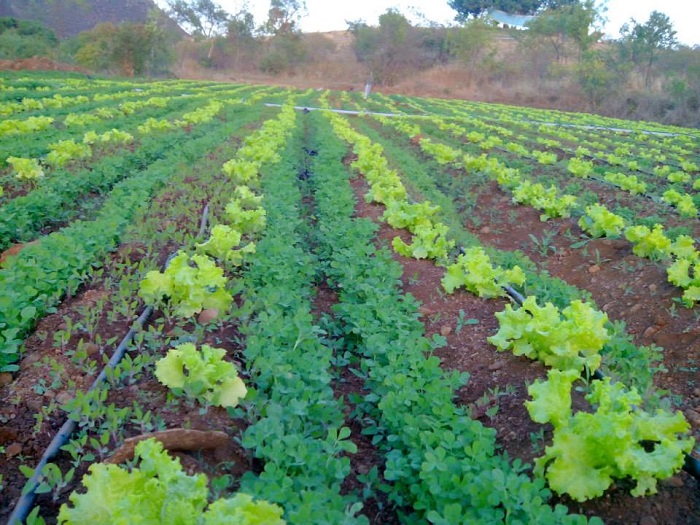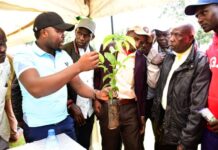Intercropping has been receiving little to no acknowledgment at all from scientists. This is despite its practice being around for centuries by millions of farmers. It is also a system which has proven to be particularly beneficial to smallholder farmers.
Intercropping involves the growing of two or more crops in the same field – in sequence, in combination, or both. This includes the practice of relay cropping; the planting of a second crop between the rows of a first crop which is almost at maturity
According to research and studies of agricultural systems, most farmers prefer, where possible, to plant at least two crops in the same field. This helps to minimize the risks of crop failure, which can prove disastrous if the farmer devotes all his resources to growing a single crop In Africa, for example, 98% of the continent’s most important legume crop – cowpea – is grown in combination with other crops. In Nigeria, for instance, over 80% of the cropland used is given over to mixed cropping.
Research has also revealed that in most instances, crop mixtures tend to produce more than individual crops grown alone. This is because the crop species complement each other with regard to such parameters as growth rhythms, rooting depths, nutrient uptake and use of water and light. This, in turn, ensures maximum production.
Advantages
Mixed cropping makes use of up to twice the level of nutrients from the soil than monoculture. Additionally, it has also been proven that mixed cropping outperformed monocultures in terms of yield of the particular crops in question. This method is well known for its efficient use of local resources. For example, short-term crops planted with others that take a year or more to mature utilize the land, water and light while the main crop is still small.
In addition, the planting of both early and late maturing crops together helps spread the harvest throughout the year. This can be particularly valuable in cases of inadequate storage or challenges faced in the same. Similarly, tall-growing crops can be combined with short-growing, shade-tolerant crops. As a result, crops such as sweet potato can be raised between the maize rows since maize respond to increase in row spacing. This will not only increase but also diversify production with no additional input.
Contrary to popular misconception, intercropping is not confined to annual crops. Among other examples, Pacific islanders grow cocoa under coconut and in East Africa bananas are interplanted with coffee, the bananas providing shade and material for mulching.
Another advantage of intercropping lies in the value of increased crop residues, measured in terms of what nutrients they return to the soil and how they improve filth. The increased rooting of mixed crops, usually extending to deeper levels than would be seen with single crops, helps to hold soils together. Moreover, by choosing a mixture of crop species, farmers can ensure that leaf coverage of their land is expanded to try and use what solar radiation and water are available to the full.
Farmers who intercrop are able to introduce a means of controlling crop pests – at virtually no cost. The effect of viruses, fungi and nematodes can all be diminished just by planting more than one crop. A study of plant-feeding insects has found that 60% of the species tested were less abundant in mixtures than in monocultures. What is more, this simple method of biological control works even on a small-scale. Moreover, several disease-resisting crop combinations have already been identified. Cassava and bean mixes reduce both incidence and severity of powdery mildew on cassava and angular leaf spot on beans. Cowpea viruses have also been found to be diminished when cowpeas are grown with cassava or plantain. Other beneficial combinations include, maize – sunflower – oats sesame, potato – mustards, and okra – tomato – ginger – mugbean grown under coconut trees. Cowpeas appear to be protected from insect attack by inter-planting with sorghum or other cereals, and okra protects cotton from flea beetles.
In other cases, simple physical characteristics of individual crops, when combined, can provide protection. This serves to disrupt the visual processes by which insect pests home in on their food. It also deters colonization by weeds. For instance, it has been discovered that inter-planting kale with tomato and tobacco reduces leaf damage from cabbage-eating beetles by 75%.
Mixed-crop systems meet more of the annual needs of smallholder farmers’ families than monocrops and with less risk. In areas where hunger and malnutrition are endemic the evidence is hard to ignore. Trials of sorghum/pigeon pea mixtures showed that, for a given ‘disaster’ level, sole pigeon pea crops would fail one year in five, sole sorghum one year in eight, but that intercrops would fail one year in 36 Technique for the future Intercropping offers definite potential for the future.
It is important to note that new varieties need to be tested in typical mixtures and specific environments. Over the centuries some mistakes with crop mixture choices or husbandry have been made. For instance, weeding cannot be mechanized because of the close proximity of crops of different physical characteristics and demands. Be that as it may, this is not a major disadvantage since intercropping tends to prevent weed invasion and growth. All the same, any weeding that has to be done has to be carried out carefully and this is thus time consuming. Unfortunately, there are currently very few herbicides that can be used on mixed crops. Similarly, harvesting has to be carried out carefully so as not to damage the standing crops.









